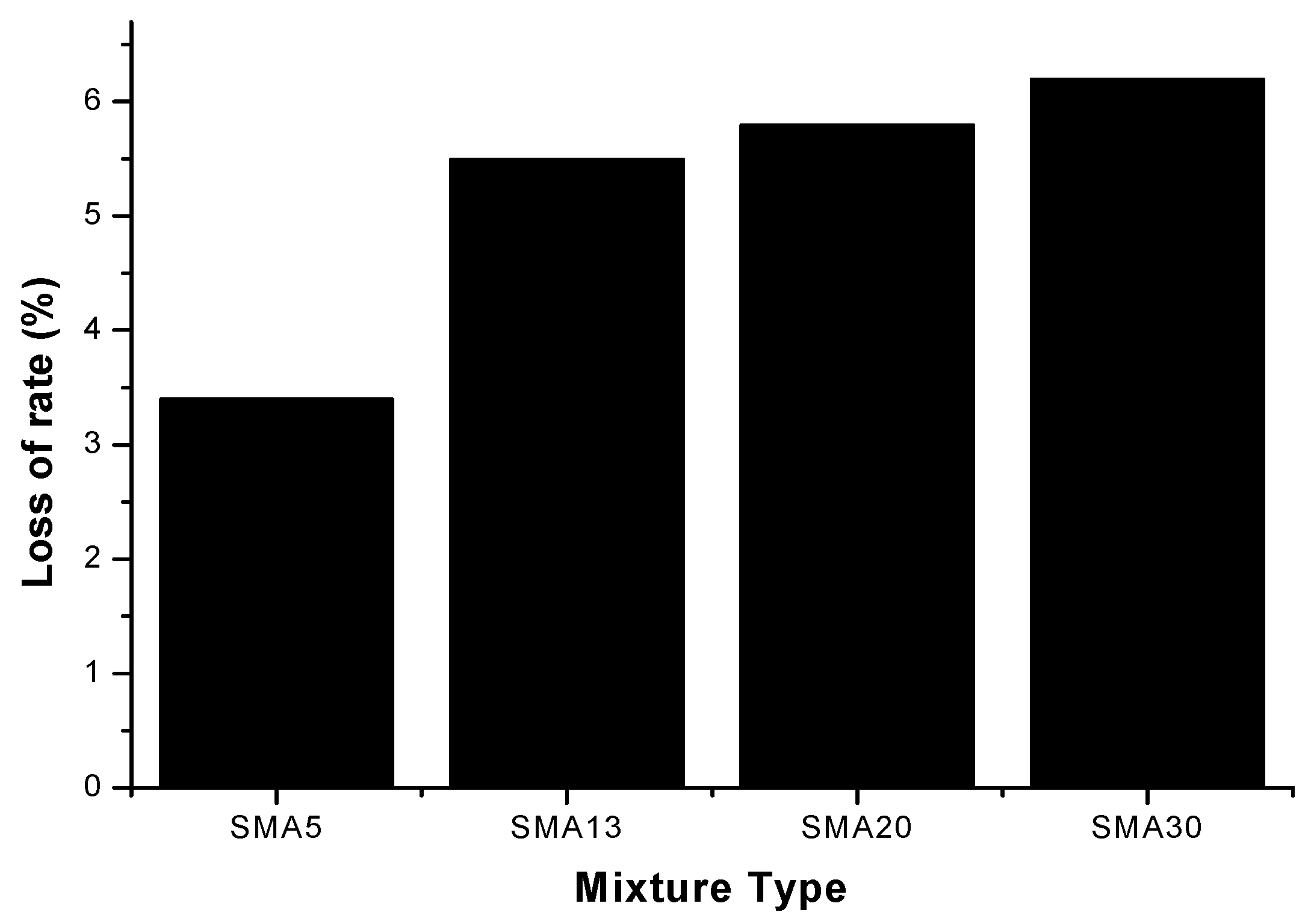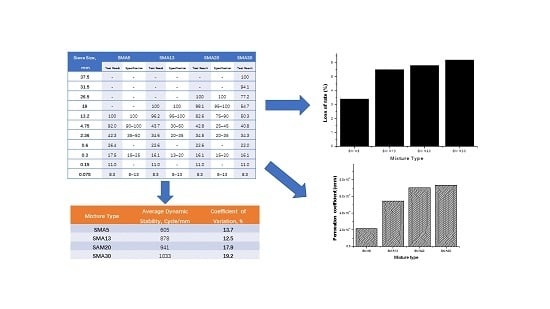1. Introduction
Stone matrix asphalt (SMA) has been used successfully in Europe for over 20 years. SMA was first used in Europe as a mixture to resist the wear of studded tires. However, an additional benefit found about SMA was its superior rutting resistance [
1,
2].
SMA is a type of hot mix asphalt (HMA) characterized by higher content of coarse aggregate and rich mastic, which is composed of relatively high contents of asphalt binder and mineral fillers, and small contents of fine aggregate and stabilized additives. Gap-graded aggregates with stone-on-stone contact renders SMA highly resistant to shear deformation. Compared with dense graded mixture, SMA contains more asphalt binder, which leads to a durable asphalt mixture with better resistance to cracking, moisture damage and age-hardening. The addition of stabilizers, such as fiber, is just used to prevent the drain down of asphalt binder during the production and placement of SMA [
3,
4].
Among all the elements in the composition of HMA, aggregate gradation is perhaps the most important one affecting the performance of asphalt mixture. Various methods for aggregate gradation design have been studied and provided. The Bailey method has been promoted in recent years to select aggregate gradation in HMA and performed well in Illinois. A set of characteristic sieves have been defined in the Bailey method according to EN 13108-1 [
5], which has offered effective tools to design and evaluate the aggregate packing in HMA. For SMA with aggregate gradation designed by the Bailey method, low water damage and in turn good durability can usually be accomplished [
6]. However, due to the lack of extensive verification in field, the Bailey method is still not fully known to help designers to choose appropriate aggregate gradation [
7].
For the HMA designed by Superpave mix design procedure, aggregate gradation is not only crucial to the volumetric properties, but also an important determining factor in the performance of asphalt mixture. The aggregate gradation is known to affect the stiffness, stability, durability, permeability, workability, fatigue resistance, skid resistance and moisture sensitivity of asphalt mixture [
8].
According to the results of an investigation by Ruth et al., a well-balanced, continuously graded mix provides the best rut resistance for Superpave mixtures [
9].
Hot mix asphalt mixtures with a larger maximum aggregate size generally exhibit a resistance to permanent deformation that is superior to that of mixes with a smaller maximum aggregate size. The effect of NMAS on SMA designed mixtures is of considerable interest, the research was needed to objectively assess the role of NMAS in the overall performance of SMA.
For bases that use a dense-graded friction course (Splittmastic asphalts) and an open-graded frication course (porous European mixes), it is well known that pavement texture impacts surface performance, type-vehicles interaction and road safety. At a given level of compaction, the thickness of the sample affects volumetric, texture spectrum and the expected life of the pavement [
10,
11].
David Woodward et al. summarized a laboratory investigation into the Wear Stone Mastic Asphalt road surfacing material. They found that 14 mm and 10 mm SMA behave in similar ways using The Road Test Machine. The main difference is that SMA14 has greater possible macrotexture [
12]. SMA has special composition and structure which is different from common asphalt mixture. To find out what influence the aggregate characteristics have on performance, we need to evaluate the effects of different NMAS on SMA by various fundamental engineering tests, such as the wheel tracking test, three-point bending test, permeability test and Cantabro test. The results are conducive to guide the design and application of SMA in actual projects.
3. Gradations of SMA Mixtures
The gradations of SMA5, SMA13, SMA20 and SMA30 are presented in
Table 5.
All the asphalt mixtures were designed with the standard Marshall method to determine the optimum asphalt content. The detailed design procedure can be seen in
Figure 1. The Marshall Specimens of SMA5, SMA13 and SMA20 mixes were 63.5 mm high and 101.6 mm in diameter, and compacted using 75 blows on each side. The Marshall Specimens of SMA30 were 95.2 mm high and 152.4 mm in diameter, and compacted using 112 blows on each side.
The mix design results for four SMA mixtures are summarized in
Table 6, in which optimum binder content, Air voids (AV), Voids in mineral aggregate (VMA), Voids filled with asphalt (VFA), Stability, flow value and retained stability are included.
Table 6 shows that air void decreased, and VMA and VFA increased with the decrease of NMAS in aggregate gradation, but the stability failed to present inerratic changing trends for SMA mixtures with different NMAS. The optimum asphalt contents shown in
Table 7 varied from 4.5% to 6.4%. By comparison, SMA30 had the lowest optimum binder content among all the mixtures. For the retained stability, it increased marginally with decreased NMAS.










